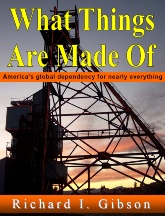
Some interesting oil industry statistics - largest ...
©1997-2009 Gibson Consulting
 | By Richard Gibson: What Things Are Made Of The story of America's dependency on mineral commodities (including oil) in everyday life. Buy the book. Print (312 pages): $17.95; electronic (PDF) $9.99. Additional e-versions details to come. visit the blog | Share this article Tweet | Support this page! |
20 largest oil producers, in million barrels per day:
(source: mostly Oil & Gas Journal, World Oil, and EIA)
| Country and 2004 rank | Estimated Reserves (billion barrels, 2006) Source |
2004 Production Includes Crude Oil, NGL, Condensate, Refinery Gain |
|---|---|---|
| 1. Saudi Arabia | 267 billion bbl | 10.4 mb/d |
| 2. Russia | 60 | 9.3 mb/d |
| 3. USA | 21 | 8.7 mb/d Crude oil = <5.2 mb/d |
| 4. Iran | 132 | 4.1 mb/d |
| 5. Mexico | 13 | 3.8 mb/d |
| 6. China | 18 | 3.6 mb/d |
| 7. Norway | 8 | 3.2 mb/d |
| 8. Canada | 179 (includes tar sands) | 3.1 mb/d |
| 9. Venezuela | 79 | 2.9 mb/d |
| 10. United Arab Emirates | 98 | 2.8 mb/d |
| 11. Kuwait | 104 (some sources say 48 billion - the difference is 5% of world reserves) | 2.5 mb/d |
| 12. Nigeria | 36 | 2.5 mb/d |
| 13. United Kingdom | 4 | 2.1 mb/d |
| 14. Iraq | 115 | 2.0 mb/d |
| 15. Other FSU Mostly Kazakhstan + Azerbaijan | 47 | 1.9 mb/d |
| 16. Algeria | 12 | 1.7 mb/d |
| 17. Brazil | 11 | 1.5 mb/d |
| 18. Libya | 39 | 1.5 mb/d |
| 19. Indonesia | 4 | 1.1 mb/d |
| 20. Angola | 6 | 0.9 mb/d |
 The largest oil field in the world (Ghawar in Saudi Arabia) contains an estimated ultimate recoverable 75-85 billion barrels of oil, or nearly 6 times Prudhoe Bay, in Upper Jurassic shallow-water carbonates in a broad anticline.
The largest oil field in the world (Ghawar in Saudi Arabia) contains an estimated ultimate recoverable 75-85 billion barrels of oil, or nearly 6 times Prudhoe Bay, in Upper Jurassic shallow-water carbonates in a broad anticline.
